Coastal Heritage Magazine
Offshore Wind: Testing the Water
Offshore wind is South Carolina’s primary renewable resource for generating electricity. Can the state establish effective incentives to develop it? Or will offshore wind prove too expensive and difficult?
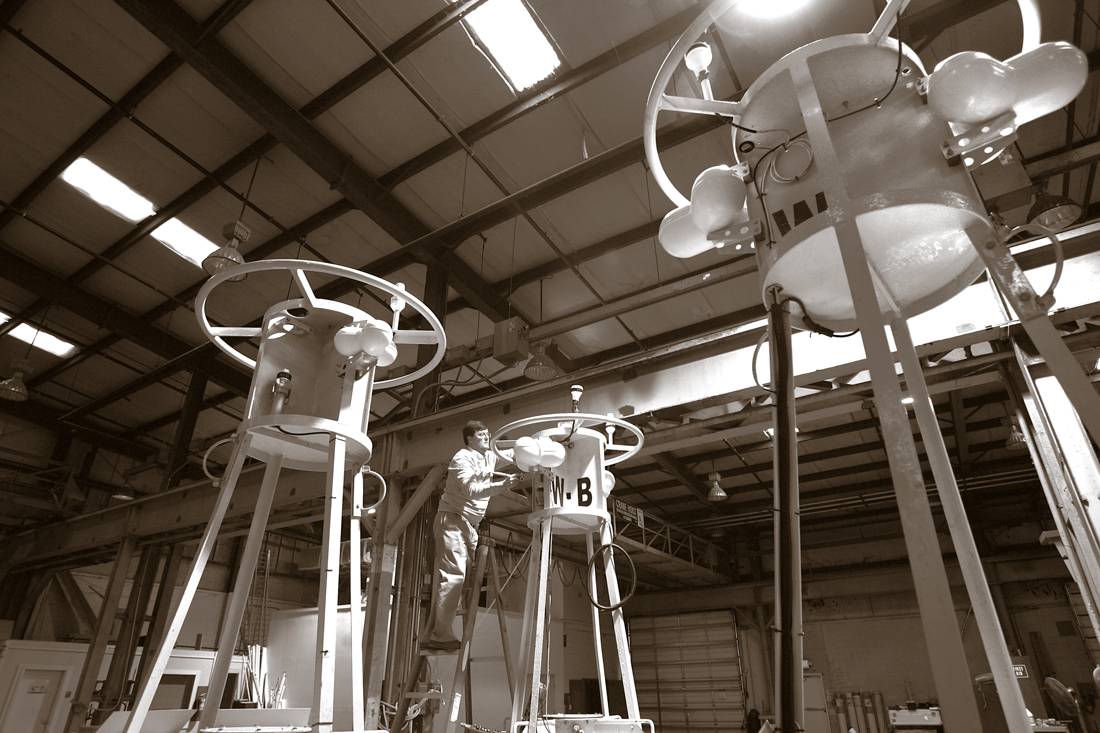
Scout. Paul Gayes of Coastal Carolina University replaces lights on buoys that measure wind speed, direction, and frequency off the South Carolina coast. Photo by Wade Spees.
Offshore Wind: Testing the Water
Within a few years, wind turbines could be spinning off the East Coast, their flashing blades capturing Atlantic Ocean winds and producing clean, renewable energy for coastal communities.
The U.S. Atlantic seaboard from Maine to South Carolina is blessed with a broad, shallow continental shelf where winds blow hard and steadily much of the time. Five northeastern coastal states—from Delaware to Massachusetts—are poised to construct wind farms in the sea and recruit wind-power manufacturers in an effort to stimulate new, green industries and jobs.
“There’s also a growing realization in South Carolina,” says Ralph Nichols, a Savannah River National Laboratory engineer, “that we have to do something with offshore wind, which is our main renewable energy resource for electricity generation.”
Can South Carolina catch up? “The states that are ‘first in’ would get the economic benefits” of developing a manufacturing base for wind power and technical skills of its workers, says S.C. Sea Grant researcher Paul Gayes, director of the Center for Marine and Wetland Studies at Coastal Carolina University. Pioneering states would have a better chance of attracting companies that manufacture, assemble, install, or service wind turbines, blades, cables, and wind-turbine foundations.
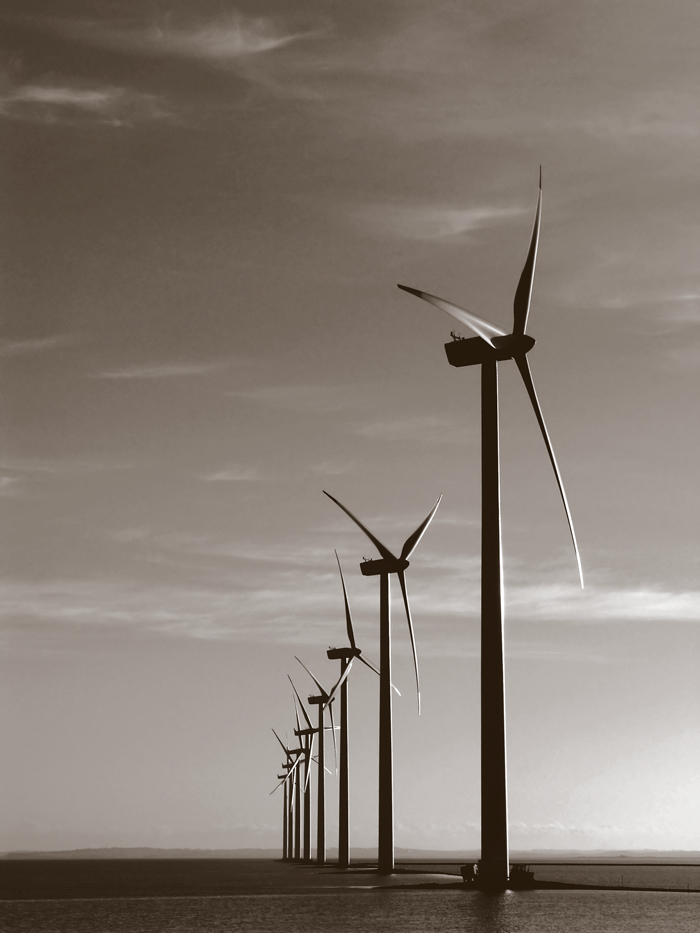
On the Cover. Many European countries have created incentives for companies to reduce carbon emissions, leading to a boom in offshore – wind generation. Photo by Povl Peterson, Dreamstime.
Several Atlantic seaboard states “are really stepping out with initiatives to promote this industry in their coastal areas,” says Nicholas Rigas, director and chief scientist of the new wind-turbine test lab at the Clemson University Restoration Institute in North Charleston and vice president of EcoEnergy, a wind farm-project development company. “I think that’s the one thing that South Carolina has been lacking.”
Ten coastal states from Maine to North Carolina have passed laws requiring utilities to generate a quota of electricity from renewable resources within the next five to 20 years. Fourteen more states around the country, plus the District of Columbia, have also established quotas (called “renewable portfolio standards”) that are spurring utilities to develop indigenous sources of clean power such as wind and sun.
“The key to the development of renewable energy has been the state measures,” says Hamilton Davis, a program manager with the Coastal Conservation League, a nonprofit organization in South Carolina. “Progress in this field wouldn’t be happening otherwise.” Now, many state deadlines for renewable use are looming. “If you don’t meet your quota, you’ll have to buy power from states that are farther ahead in developing green energy,” says Davis. South Carolina has not passed a renewable portfolio standard.
Of eight states with plans to develop offshore wind power, six have renewable-energy mandates, according to Catherine Van Houten, project manager with the S.C. Energy Office.
Still, there are concerns about offshore turbines’ impacts on wildlife, particularly birds and marine mammals, and property owners have opposed wind-farm proposals for aesthetic reasons. Some beach visitors in South Carolina might admire an offshore wind turbine as having a modern, graceful kind of beauty, while others could see it as a blight against nature and take their vacations and business elsewhere.
“The conversation here about offshore wind has always been positive,” says Jim Eggen, general manager of Myrtle Beach Seaside Resorts based in North Myrtle Beach. “We think that any wind turbines would be some distance offshore. They will only be a very small part of the vista. Maybe people will even take cruises out to watch the sun set over the wind turbines.”
There are no plans—yet—to build a wind farm in the ocean off South Carolina. But Santee Cooper, the state-owned utility, Coastal Carolina University, and the S.C. Energy Office have undertaken a project called the Palmetto Wind Research Project to deploy buoys to document offshore winds along the northern stretch of the South Carolina coast. This area comprises a large portion of Santee Cooper’s service area and has the state’s strongest winds close to shore.
Weather buoys and land-based stations are measuring wind speed, direction, and frequency at stations up to six miles out into the ocean. One string of buoys is installed off Winyah Bay and another begins at Waites Island, near Little River. Sometime in 2010, Santee Cooper will also install an offshore platform near one of the buoy paths. For at least a year, instruments on the platform will measure upper-level winds similar to those a wind turbine would encounter.
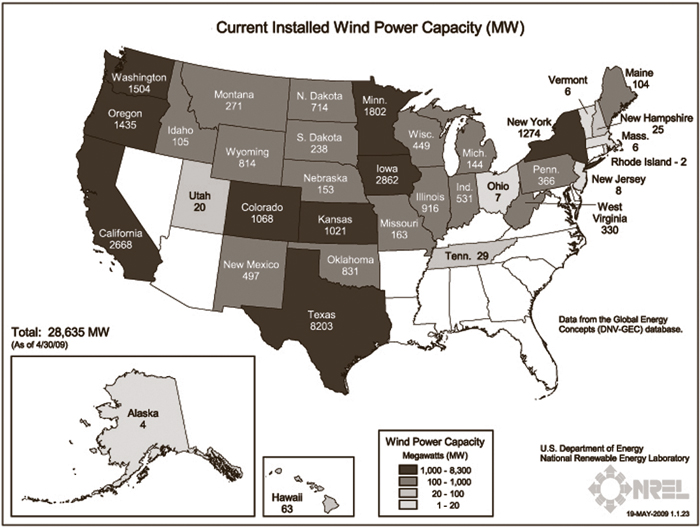
The Great Plains and the West Coast are leaders in developing land-based wind energy. Now several Atlantic and Gulf Coast states seek to harvest their own wind resources, which are almost exclusively offshore. Source: National Renewable Energy Laboratory.
“The wind resource is out there,” says Paul Gayes, who is collaborating with Len Pietrafesa of the University of North Carolina–Chapel Hill on the Palmetto Wind Research Project. “Europe has more than three decades of experience in developing offshore wind power, and now it’s coming here” to the United States. Twenty percent of Denmark’s electricity, for instance, is generated from offshore wind. “The question is whether South Carolina can become a leader in the Southeast or whether we’ll arrive late and miss important opportunities.”
Many conservation groups in South Carolina have, so far, been supportive of a potential offshore wind farm. Says Ralph Nichols, “Conservation groups recognize every effort is being made to mitigate negative impacts and they are weighing the impacts against the impacts from climate change and other fuels.”
Some jobs associated with offshore-wind power would be located in industrial facilities as near as possible to major port facilities like Charleston’s. “The offshore generators are very large machines, and because of their size they would have to be assembled at the coast,” says Rigas. They are too big to be transported long distance on highways.
General Electric (GE), the second largest supplier of wind turbines in the world, assembles land-based machines in its Greenville, S.C., plant. There are more than 8,000 precision parts in a single wind turbine, and some of GE’s suppliers have also sited factories in the upstate. But the Greenville GE plant builds relatively small turbines, and offshore turbines would be far larger.
The Port of Charleston has already helped attract a major wind-energy research effort to the lowcountry. The Clemson University Restoration Institute and its partners have acquired $98 million in grant and matching funds to plan and operate a facility to test next-generation wind turbines and drivetrains at the institute’s research campus on the former Navy base in North Charleston. It’s expected to open in 2012. Clemson officials said that proximity to the port was crucial to its choice of the North Charleston site for the testing facility.
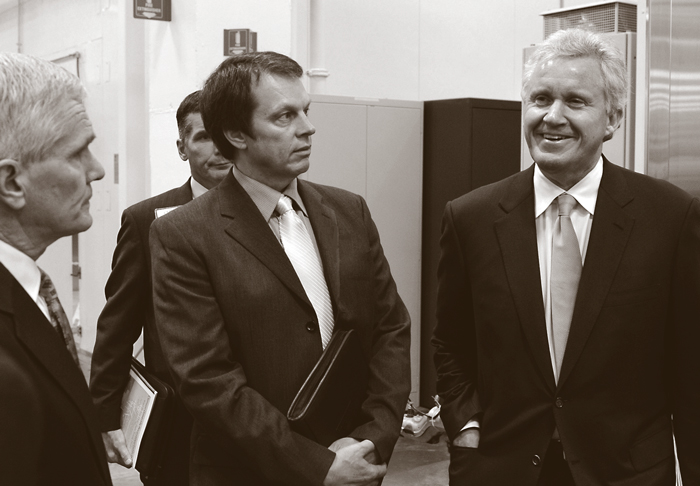
Groundwork. (Left to right.) Clemson University President James F. Barker and John Kelly, Clemson vice president and executive director of the Restoration Institute, talk with Jeffrey Immelt, chairman and chief executive officer of General Electric, at a Dec. 8, 2009 energy summit held at Clemson’s International Center for Automotive Research. Photo by Craig Mahaffey, Clemson University.
Most Atlantic seaboard states are energy-poor, although they are among the nation’s largest consumers of electricity. They must buy coal or natural gas from beyond their state borders to run power plants. Building new nuclear-power plants might still be difficult for political and permitting reasons, and the Atlantic shoreline lacks significant solar and onshore-wind resources. But the East Coast does have strong offshore winds that some states are poised to exploit for electric power.
The Obama administration, meanwhile, has made renewable offshore energy a priority. In 2009, the Minerals Management Service, an agency within the U.S. Department of Interior, established rules that define how wind power facilities would be permitted in federal waters from three to 200 miles offshore.
“With the prior administration, those rules didn’t exist,” says Rigas. “So no one really knew how to permit any projects in federal waters.” Most major offshore wind farms will probably be built in federal waters, he says, although smaller projects have been proposed in state waters in the Northeast.
In South Carolina, a task force has been established to examine regulatory and permitting roadmaps involved in siting potential alternative energy projects in state or federal waters.
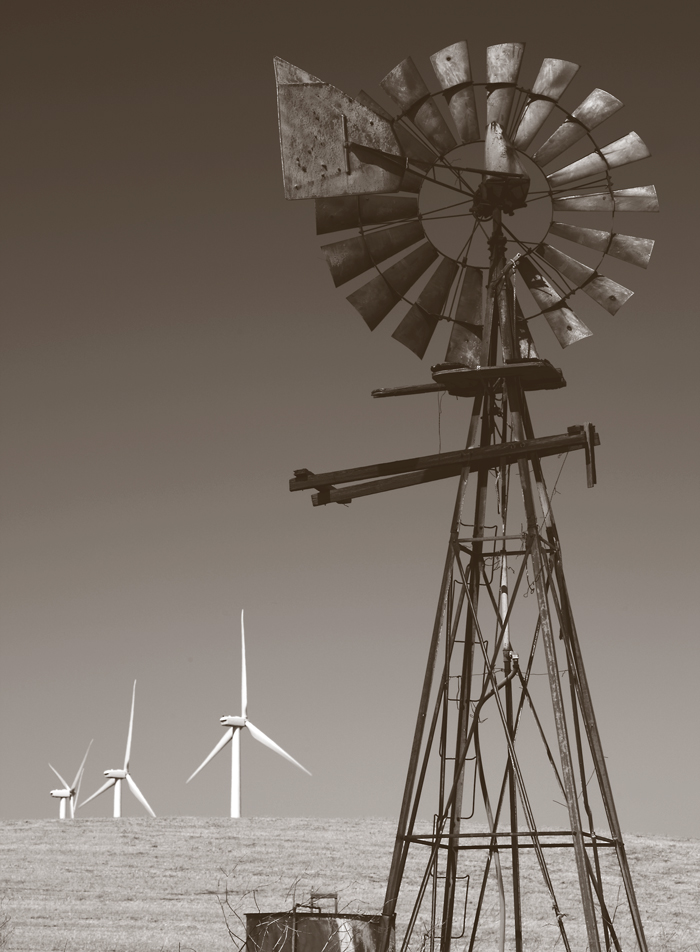
Wind Farm. In some American rural areas, windmills still draw up groundwater while wind turbines provide electricity to growing communities. Photo by Terrance Emerson, Dreamstime.
Moreover, the S.C. General Assembly appointed a Wind Energy Production Farms Feasibility Study Committee to examine offshore wind energy. The committee, which re leased its report on December 31, 2009, offered 18 recommendations to help the state prepare for development of wind-power generation and associated industries in South Carolina.
The committee recommendations include the following:
- South Carolina should establish clean-energy portfolio standards with targets for offshore wind and other renewable resources, energy efficiency, and nuclear energy.
- South Carolina should establish a leasing framework for offshore activities in state waters, a one-stop permit facilitation process for offshore projects, and wind-energy manufacturing incentives.
- The new wind-turbine test facility at the former Charleston Naval Base should become a focal point for a nascent offshore wind industry in South Carolina.
- The state should develop a “marine-spatial plan” for its offshore waters through the S.C. Department of Health and Environmental Control. A plan would allow predictability in decisionmaking and help avoid conflicts with traditional ocean uses.
- The S.C. Sea Grant Consortium should work with its member institutions and federal partners in South Carolina to develop a “premiere marine-resource enterprise for the East Coast” similar to the Woods Hole Oceanographic Institution. The enterprise could facilitate environmental impact studies for future offshore wind farms and other offshore operations.
New Energy Mix in the Globalized Economy
Two hundred years ago, Americans harvested energy from wind, river flow, plants, and whales. Windmills and water mills powered agriculture and industry. Plant food provided energy for mules and horses that pulled farm plows and carriages. People burned wood for heating and cooking in their homes. Whale oil fueled lamps for lighting.
Today the United States generates almost three-fourths of its electrical power from fossil fuels: coal (49 percent), natural gas (22 percent), and petroleum/petroleum coke (1 percent). Other sources include nuclear power (20 percent) and hydroelectric dams
(6 percent). Wind power provides about 1 percent, and other sources such as solar, biomass, and landfill gas generate the remaining 1 percent.
Coal burning, which generates about 40 percent of South Carolina’s electricity, not only emits mercury and other contaminants into waterways but it also has the largest “carbon footprint” of any fuel. Coal is the “highest-carbon” fuel, producing the most carbon dioxide (CO2) per unit of energy. Natural gas, with half of coal’s carbon footprint, is a “mid-carbon” fuel. Wind power, by contrast, is squeaky clean, a “no-carbon” fuel.
From smokestacks of fossil-fueled power plants, CO2 is sent into the Earth’s atmosphere where it captures a portion of the sun’s radiant energy and raises the temperature of the Earth, causing greenhouse warming. Climate scientists agree that unless the international community takes swift, decisive action to slow CO2 and other greenhouse-gas emissions, the Earth is on track toward dangerous warming, causing increased storms, droughts, floods, and other natural disasters.
Can we return to the days of extracting most of our energy from wind, water flow, and plants? No, not anytime soon. Still, the United States could significantly increase its use of renewable energies, though that would require an expensive, concerted effort to develop new technologies, improve existing ones, and seamlessly link them together around the country. Many of the most promising areas for wind and solar power are not being developed because they are too far from the places that would use it.
Someday, electricity generated in windy and sunny regions could be distributed via ultrahigh-voltage power lines as part of a linked, national “super-grid.” Upgrading today’s antiquated transmission system is essential to scaling up renewable energies.
“Most of our transmission system is 30 to 50 years old,” says Nina Plaushin, director of federal and legislative affairs with ITC Holdings Corporation, a company that builds electric-transmission infrastructure. “It’s stressed and old. There’s a lot of congestion and it doesn’t know where it needs to go. If we don’t build more transmission, we are not going to be able to get renewables to market.”
Another problem with wind power is that it’s erratic. Offshore breezes go slack. Turbines rely on wind speed and direction, which often change. Storm winds aren’t an advantage either, because the electric grid can’t store the extra energy, so it’s wasted. Solar is intermittent as well.
But visionaries see a time when energy from wind and sun will be stored in super-batteries or other large storage devices. Utility computers could manage electricity flows over nimble, computerized “smart grids” that communicate with—and adjust juice to and from—batteries that power plug-in hybrid or all-electric vehicles. Think of it this way: someday a gasoline-station pump would be replaced by a super-battery; a gasoline hose would be replaced by the electric grid; and the gas tank would be replaced by a car’s plug-in battery. General Motors plans to roll out North America’s first plug-in hybrid vehicle, the Chevrolet Volt, in 2011.
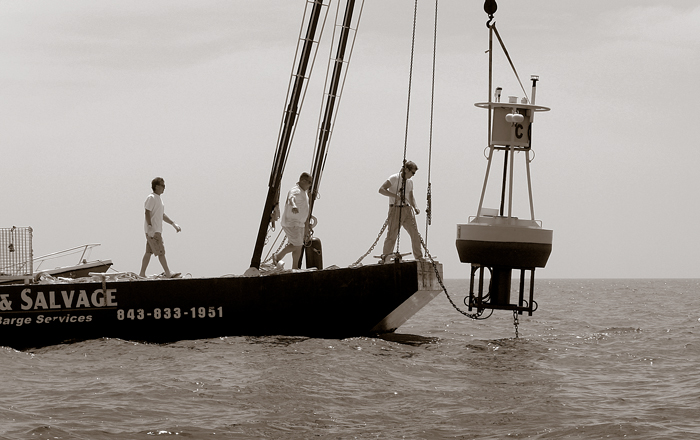
Measuring Potential. As part of the Palmetto Wind Research Project, scientists deploy ocean buoys and instruments to capture offshore wind data. Photo by Angela O’Brien-Gayes.
Smart grids, in turn, would make household energy use far more efficient, and households with their own solar panels or wind turbines could sell excess energy to the local utility.
Nuclear energy, which is low-carbon, probably should be expanded to meet growing electricity demands, many scientists say. By also increasing energy efficiency, the United States could reduce its dependence on foreign fuel sources, cut greenhouse-gas emissions from power plants, and build green-energy industries.
But the United States is falling behind China in this arena.
China has wildly contradictory policies on energy development and climate change, as if it were two separate countries racing in opposite directions. China has become the global leader in greenhouse-gas emissions, building a new, dirty, inefficient coal-fired electric plant almost every week, particularly in its poorer western provinces.
At the same time, China’s eastern seaboard is increasingly prosperous and forward thinking. Eastern cities, including Beijing and Shanghai, have become centers of innovation in development of high-tech, low-carbon power as they scramble to stem choking air pollution, slow contributions to climate change, and sustain blistering economic growth.
Indeed, China’s renewable-energy development is moving so quickly that it will soon be the international leader in wind and solar power, and its super-grid transmission system could soon become the most advanced in the world, according to former Vice- President Al Gore.
In 2005, China, the world’s fastest-growing market for wind power, established favorable tax advantages for low-carbon energies, which are slated to meet 15 percent of the nation’s electricity needs by 2020. The International Energy Agency reports that China has made dramatic investments in energy efficiency, too.
Thomas Friedman, the New York Times columnist, recently warned: “China is committed to overtaking us in electric cars, solar power, energy efficiency, batteries, nuclear power, and wind power. China’s leaders understand that in a world of exploding populations and rising emerging-market middle classes, demand for clean power and energy efficiency is going to soar. Beijing wants to make sure that it owns that industry and is ordering the policies to do that.”
“In their actual behavior, they are getting more prepared to live in a low-carbon world than we are,” says James Rogers, president, chairman, and CEO of Duke Power Corporation.
Atlantic Coast Leaders in Offshore Power
Wind turbines can be noisy, and some people complain they ruin the view, so turbines are usually placed where towns are few and far between. In 2008, the United States became the world’s leading wind-energy producer after years of building land-based turbines across the rural heartland. China has advanced a similar land-based strategy, building wind farms in its desert and mountainous regions, though in September 2009 it connected Asia’s first offshore wind farm in waters near Shanghai to the grid.
U.S. wind farms have sprung up across the Great Plains and the Upper Midwest from frozen Minnesota to sun-scorched West Texas, along rocky Appalachian ridgelines, in open spaces in New York and California, and in the Pacific Northwest. Wind power accounted for 42 percent of all new electric generating capacity added in the U.S. in 2008.
Still, not a single turbine has been built in some of America’s windiest places—its oceans or Great Lakes. That will change soon.
Nine years ago, investor Jim Gordon proposed the Cape Wind project to install 130 wind turbines on Horseshoe Shoal in Nantucket Sound five miles off the Massachusetts coast. Average winds would provide Cape Cod, Martha’s Vineyard, and Nantucket with 75 percent of their energy needs.
A coalition of fishermen and homeowners, including the late Sen. Edward M. Kennedy of Massachusetts, bitterly fought the project, saying it would harm seascape views, dampen tourism, ruin fishing and boating, kill birds, and damage a variety of other wildlife.
Cape Wind was proposed at a time when government policies weren’t in place to manage offshore energy projects, but that is changing rapidly on both state and federal levels. Recently, though, Cape Wind cleared a number of permitting hurdles, and a study by the Minerals Management Service, the federal agency that oversees offshore wind power, found that Cape Wind would pose no serious environmental threat.



Viewpoints. The photo simulation at top shows how wind turbines might appear at distances (from left to right) of two, three, four, five, six, seven, and eight miles off the South Carolina coast. The middle photo simulation shows how wind turbines might appear off northern Horry County at a distance of 7.3 miles. The photo simulation at bottom shows how wind turbines off Winyah Bay might appear from DeBordieu about 8.7 miles away. Source: Santee Cooper and Clemson Univeristy’s South Carolina Institute for Energy Studies.
Within two years, if all approvals are acquired, Cape Wind could become the nation’s first offshore wind farm connected to an electrical grid—if it doesn’t get nosed out by a proposed project near Block Island, Rhode Island, or one near the Boston suburb of Hull, Massachusetts, both in state waters.
A number of environmental groups have lined up to support offshore-wind development in locations where potential effects on wildlife and marine mammals are expected to be minimal.
“Some think that the fight is between building offshore wind farms and not building offshore wind farms,” says Simon Mahan, a campaign analyst with Oceana, an international ocean-conservation group. “But in many cases the fight is actually between building offshore wind farms and building coal-fired power plants.”
The federal government has awarded five “research leases” to three companies that intend to install wind turbines off the New Jersey and Delaware coasts. They’re the first such leases ever issued for the Outer Continental Shelf, from three to 200 miles off the U.S. shoreline. Those projects could be linked to an electricity grid by 2012 to 2014. Northeastern states are taking the national lead in developing offshore-wind projects in part because that region is dependent on often-costly natural gas for electricity.
Other offshore-wind projects farther back in the pipeline have been proposed in New York, Oregon, Georgia, the Gulf of Mexico, and on the Great Lakes.
“South Carolina is a little bit behind other states,” says Steve Kopf, a partner with Pacific Energy Ventures, a consulting firm focusing on renewable energies. “But it’s a great time to catch up and learn from experience in other parts of the country.”
Wind Won’t Displace Fossil Fuels
With its rollercoaster of gusts and doldrums, wind power frequently isn’t there when you need it or in the right quantities. Wind energy, therefore, usually can’t be used as a dominant fuel for electricity. Utilities depend on more reliable fuels—coal and natural gas—to provide the grid’s “base load” and smooth out wind’s erratic characteristics.
A kilowatt-hour of renewable wind power added to a grid can re place the same amount of electricity from a polluting source such as coal or natural gas. Developing wind power, therefore, could slow the acceleration of greenhouse-gas concentration in the atmosphere and stall climate-change impacts.
But what happens to an electric grid when the wind falters and turbines stop spinning? American utilities that depend heavily on wind power build backup plants, usually fired by natural gas, to meet electricity demand when winds stop. (An electric company can burn more coal, but it’s expensive and time-consuming to scale up a coal-fired plant. Nuclear and hydroelectric plants provide continuous electricity; they’re always on.)
Natural-gas generators can be turned on when winds falter and turned off when winds are strong. The price of natural gas, however, is notoriously unreliable. “The single most volatile commodity [in terms of price] on any exchange anywhere in the world is natural gas,” says Gale Klappa, chairman, president, and CEO of Milwaukee-based Wisconsin Energy Corporation.
In any case, an electric company that uses wind turbines must have a supplemental source of power.
“With wind, you’re paying twice for power generation,” says Marc Tye, Santee Cooper’s vice president of conservation and renewable energy. That is, utilities pay once for wind power and once for a supplemental power generation. The backup capacity, he says, “would cost money whether it runs or not.”
China, heavily dependent on coal for electricity, is planning to build numerous coal-fired generators in an effort to back up new wind farms. About 80 percent of China’s electricity comes from coal, but China is building land-based, wind-power generators faster than any country in the world.
Shi Pengfei, vice president of the Chinese Wind Power Association, has said that China would not only have to add many coal-fired generators by 2020 to keep up with its rapidly growing economy, but the nation would also have to build some of those generators even sooner to provide power when winds die down and wind turbines aren’t turning.
Chinese leaders, then, plan to reduce the nation’s dependence on coal-fired power plants, but they must build additional coal-burning capacity to do so.
Price is a Roadblock
Offshore-wind power won’t come cheap. Santee Cooper officials anticipate that it would cost $119 to $156 per megawatt-hour in 2008 dollars to harvest electricity from South Carolina’s ocean winds—but only if the utility can locate strong, steady winds within several miles of the coast.
That’s far more expensive than generating electricity from burning coal, which costs about $45 to $65 per megawatt-hour in a power plant without carbon-capturing technology in South Carolina. It’s difficult to say how much it would cost to add carbon-capture technologies to new coal-fired plants or retrofit older ones because these technologies have not yet been tested on a commercial scale.
No other fuel comes close to coal in terms of dollars and availability. In South Carolina, burning natural gas for electric power has a price range of $55 to $110 per megawatt-hour, and nuclear power costs roughly $75 per megawatt-hour, although some nations have seen costs of $111 to $145 per megawatt-hour.
Land-based wind power in the Upper Midwest costs only $40 to $50 per megawatt-hour, about one-third the price of offshore wind.
Why is offshore wind so expensive when it uses many of the same technologies as land-based turbines? Primarily because the ocean is a harsh environment. Salt spray rusts machinery and blades. Waves and currents batter foundations. Installing turbines and towers far from shore, moreover, is technically difficult. Specially outfitted ships and other expensive equipment are required to install and repair infrastructure and machinery offshore.
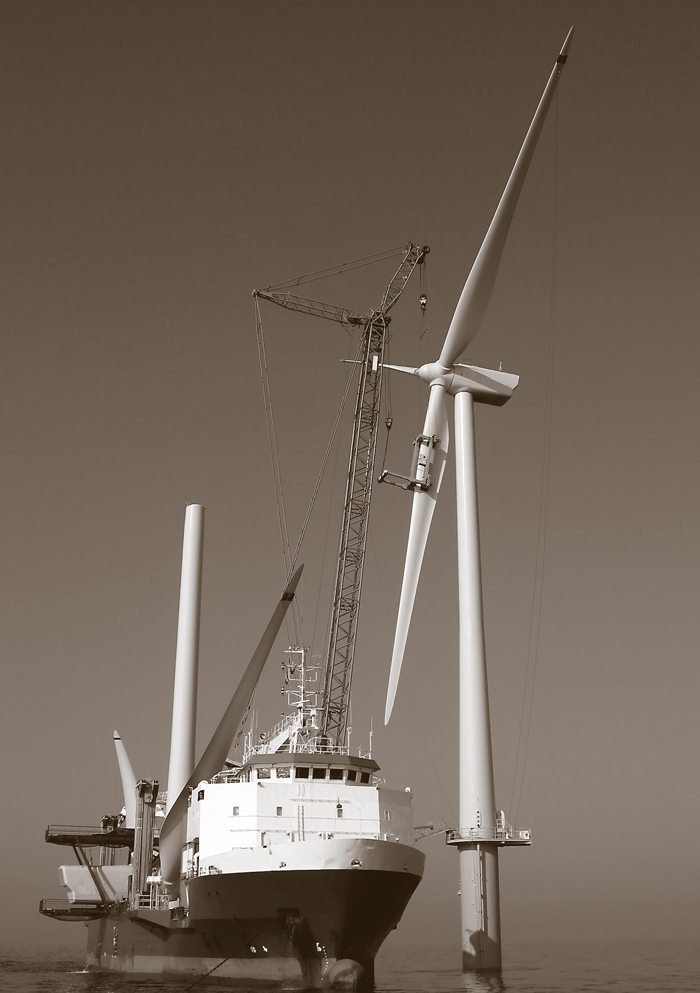
Cost-Benefit. Offshore wind turbines are far more expensive to install and maintain than land-based ones. Photo by Yobidaba, Dreamstime.
Nevertheless, offshore wind will become more attractive to utilities and their customers as the cost of burning coal increases. Today’s cheapest fuel for electricity—coal—has the most extensive environmental costs, especially in regard to climate change, and those costs have not yet been factored into electric rates.
In October 2009, the U.S. Environmental Protection Agency issued proposed rules to regulate greenhouse emissions for the first time. The proposal would cover 14,000 power plants, refineries, and other large facilities that, together, produce more than 70 percent of the nation’s greenhouse-gas emissions. The U.S. House of Representatives passed a bill that would reduce greenhouse gases and make burning fossil fuels more expensive over time, and the Senate is debating a similar bill.
Santee Cooper officials, of course, are watching Washington closely. The state-owned utility spent $245 million on a plan to build a $1.2 billion coal plant in Florence County. In August 2009, Lonnie Carter, president and CEO of Santee Cooper, announced that the utility decided to suspend permitting activities on the coal-fired plant.
One reason for the suspension, Carter has written, is that proposed federal regulations associated with coal burning eventually “could have tremendous cost implications” for Santee Cooper customers if the Florence County coal-fired plant were to be built and deployed.
Offshore’s Big Potential
Offshore wind has the potential to generate more utility-scale power than any other renewable resource in South Carolina.
What about solar power? Some households are installing solar panels that run dishwashers and televisions. Colleges and universities are using solar power to lower their electric bills. Still, South Carolina’s solar power isn’t sufficient to make a dent on a utility scale, though on a small scale it can be cost-effective.
The state’s land-based wind is modest too, yet some Grand Strand hotels are experimenting with turbines on their roofs in an effort to lower their energy costs. Santee Cooper, moreover, is generating electricity from biomass (forestry-waste products) and landfill gas.
If wind turbines and other technologies were improved, ocean-sited turbines could generate 10 to 20 percent of South Carolina’s electricity by 2030, says Ralph Nichols of the Savannah River National Laboratory.
Europe is the pioneer and world leader in exploiting offshore wind for energy. Hundreds of huge wind turbines have been built in the North Sea, providing electrical power to Denmark, Germany, and other countries, where governments have driven up costs of burning fossil fuels as part of their international treaty commitments to fight climate change. Through a cap-and-trade system and other measures, many European countries have created strong incentives to companies to reduce carbon emissions, and that has led to a boom in wind power.
But decades of experience in European waters show that offshore turbines have a high failure rate. Turbines and blades rust, and it’s pricey to maintain them—by some estimates twice as costly as those on land.
Now factor in major hurricanes. “A big hurricane would destroy a wind facility,” says Marc Tye of Santee Cooper. “There are still oil platforms in the Gulf that haven’t been found” since Katrina. An 80-megawatt wind farm off the South Carolina coast would cost at least $350 million, and that investment could be demolished by a single giant storm. After studying the long history of hurricanes barreling north off the Atlantic seaboard from Florida to North Carolina, some investors might see installing turbines as too risky.
Offshore turbines being built today can withstand a Category 3 hurricane, scientists say, but technology will need to be improved to strengthen the turbines against even larger storms.
Finding the Sweet Spot
Offshore wind turbines are being made bigger—plus more reliable and sturdy—to compete financially against conventional energy resources. Up to a point, larger blades are more efficient than smaller ones, all other factors being equal; they generate greater power at lower cost. Some offshore wind turbines in development have blade diameters reaching 100 meters, longer than a football field.
European nations have placed wind turbines as far as 20 miles off shore, where wind speeds tend to be higher and the wind is steadier. But it’s more expensive to construct and repair a wind farm farther from the coast and transmit that electricity back to shore.
Experience in Europe has shown that a depth of 60 feet is the practical limit for building foundations for offshore wind turbines. Beyond that depth, it’s too expensive to install foundations with today’s technology. South Carolina has a natural advantage in this regard; the state’s offshore ocean is less than 60 feet deep for at least 15 miles from the coast.
Some experts suggest building wind turbines far enough from land so they can’t be seen. To reach a point where turbines are barely visible, wind farms must be built about 15 miles from the coast.
Scientists now are looking for a windy “sweet spot” off the South Carolina coast—a location where the wind blows hard and steadily, preferably close to shore though not too close, and one that wouldn’t cause major conflicts with fishermen, the military, shipping companies, or tourists, and one that wouldn’t harm too many birds and other wildlife, among many other considerations. That sweet spot might take years to find.
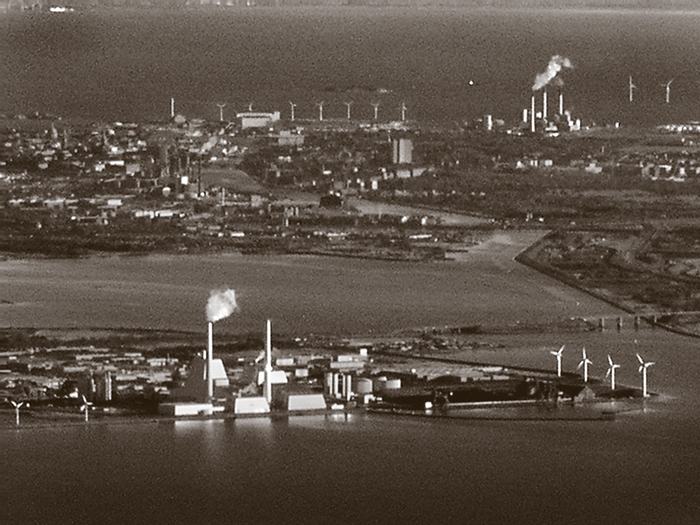
Leading the Way. Near Copenhagen, spinning turbines help Denmark derive 20% of its electricity from wind power. Photo by Wade Spees.
Over the next half-century, electric companies will be searching for additional sweet spots in renewable energies. The challenge will be to find ways to reduce and eventually eliminate carbon pollution from energy production at a reasonable price, says Hank Courtright, senior vice president of member and external relations at the Electric Power Research Institute (EPRI), an industry-supported research organization based in Palo Alto, California. “The number one job is to de-carbonize the electricity infrastructure and keep prices as level as possible.”
By 2050, Courtright says, the United States will need a mix of fuels and technologies to scale down greenhouse-gas emissions and keep electricity affordable: more nuclear power, more renewables, more efficiency, and new carbon-capture technologies in power plants that burn coal or natural gas.
Yet energy demands keep rising.
“Our reality,” says Marc Tye of Santee Cooper, “is that we don’t control what customers demand. We can try to influence them, but we can’t change behavior. If they demand more electricity, we must have the equipment to supply it. Everyone thinks we’re becoming more and more energy efficient, and that’s true. But remember all of the devices that we’ve added to our lives in recent years. Now we have personal computers, cell phones, and plasma televisions. Our consumption of electricity is going up and up and up.”
U.S. Movement on Climate Change?
America at a crossroads on greenhouse-gas emissions.
President Barack Obama has pledged that the United States would cut its greenhouse gases by 17 percent from 2005 levels by 2020. The president, however, cannot act on this pledge without congressional action. The U.S. House of Representatives has already passed a bill that would cut greenhouse gases the same amount and on the same timetable as the president’s proposal. A similar U.S. Senate bill is under consideration.
Under these bills, federal regulators would set a mandatory ceiling—or “cap”—on CO2 emissions and a national system for trading emission permits, which would offer flexibility in meeting targets. The cap on greenhouse-gas emissions would be steadily lowered over time.
If a cap-and-trade bill were passed, burning fossil fuels, especially coal, would become more costly, and taking advantage of renewable fuels such as wind and solar would be more financially attractive. The idea is to raise the price of burning older, dirtier fuels while steering investments to cleaner ones.
If passed, the House and Senate bills would also establish nationally targeted mandates for renewable energy. Twenty percent of the nation’s electricity would have to come from “non-emitting” power sources (renewables and nuclear energy) and energy efficiency by 2020.
Fifty nations around the world already have renewable energy targets, though some haven’t created incentives or regulations to encourage compliance, according to a 2009 study by PikeResearch, a market-research firm based in Boulder, Colorado.
Location, Location, Location
How do we move electrical power from isolated wind farms to growing towns and cities?
In 2009, T. Boone Pickens, the famous oilman, abandoned his highly publicized plan to build the world’s largest wind farm in the Texas Panhandle.
Pickens gave up that idea because he couldn’t solve a crucial problem: how to transmit electric power from his proposed wind turbines in isolated West Texas to people in distant urban centers. Texas had announced plans to build about $5 billion worth of transmission lines to carry wind power from the rural western part of the state to more populous cities, but those lines won’t go to locations that would have suited Pickens’ proposal. So, instead, he plans to build a handful of smaller wind farms around the Midwest.
Indeed, regions with the strongest winds are far from communities with the fastest-growing demand for electricity. To fully exploit wind power, more transmission lines will have to be constructed around the country, yet they are expensive and often face opposition from landowners and conservation groups.
U.S. Congress is also debating a proposal that would create a long-distance “transmission highway” to carry energy from midwestern wind farms and coal-fired electric plants to the power-hungry cities of the Northeast. That, of course, would be a boon for the Midwest.
But many leaders in the Northeast don’t want it, saying that such transmission lines could harm the region’s energy security, climate-protection goals, and potential green jobs.
In a letter sent May 2009 to the Senate and House leaders of both parties, 11 East Coast governors made their case against the giant super-grid between the Midwest and the Northeast. “It would hinder our efforts to meet regional renewable energy goals with regional resources and would establish financial conditions in our electricity markets that would impede development of the vast wind resources … just off our shores for decades to come.”
Planning for Activities in the Sea
More governments draw up rules to help decide how and where the coast and ocean should be used.
The ocean seems an untamed place, the last wilderness, though it’s becoming more and more crowded. Container ships plow through coastal waters, competing for space with commercial fishermen who have worked those waters for generations. On the sea floor are sand-borrow areas, fish-habitat areas, and shipwrecks. Some areas are off limits as military zones. Others are used for oil-drilling platforms. Still others are special reserves that protect whales and other marine mammals.
Because there is often little planning for the ocean, federal and state agencies have had to manage marine resources in a fragmented way, struggling to evaluate competing industries and interest groups while balancing complex trade-off decisions. These conflicts have slowed development of offshore
wind power.
But now a handful of coastal states—Massachusetts, Rhode Island, California, and North Carolina—are becoming leaders in drawing up rules and procedures to determine which uses are allowed in which places. The federal government is looking into a similar strategy.
In June 2009, President Obama established an Interagency Ocean Policy Task Force. The task force has developed recommendations for a comprehensive national policy that protects ocean and Great Lakes ecosystems and manages competing uses. A draft final report was sent to President Obama in December 2009.
“The task force is making recommendations on governance and planning [for ocean areas], setting federal policy for years to come,” says Steve Kopf, a partner with Pacific Energy Ventures, a consulting company based in Portland, Oregon.
The task force has called for “coastal and marine-spatial planning” in oceans and coasts. That is, federal and state governments should work with multi-disciplinary teams of scientists to gather data about oceans and coasts, provide an open, public process to synthesize and understand this information, and then collaborate with the public to decide how to plan various activities in the sea.
Rhode Island is more than halfway through a two-year project to compile and review data about its state and federal marine areas. Researchers have been gathering information about winds, currents, birds, fishing grounds, sea-floor depths and contours, mammal and turtle traffic, shipping lanes, military traffic, and tourism.
Policymakers and scientists are writing chapters of a new Special Area Management Plan (SAMP) that will guide uses of Rhode Island’s coast and ocean. The plan will be mostly complete in August 2010.
“We bring in the best-available science, lessons learned from other places, and people with experience from other regions to offer ideas and resolve conflicts,” says Jennifer McCann of Rhode Island Sea Grant and the University of Rhode Island Coastal Resources Center. “We have public engagement and review of all chapters of the SAMP, and there are public meetings every month, with an average of 75 people at each meeting.”
Such extensive data gathering and planning is beneficial for offshore-wind development, says Kopf. “Marine-spatial planning can give developers the confidence they need to go ahead.”
Reading and Websites
American Clean Power Association
Clemson University Restoration Institute
Electric Power Research Institute
IEA (International Energy Agency) Wind
National Renewable Energy Laboratory
Savannah River National Laboratory
Showalter, Stephanie and Terra Bowling. Offshore Renewable Energy: Regulatory Primer. National Sea Grant Law Center, July 2009.
South Carolina’s Role in Offshore Wind Energy Development. Final Report of the Wind Energy Production Farms Feasibility Study Committee, December 31, 2009
U.S. Offshore Wind Collaborative
Williams, Wendy and Robert Whitcomb. Cape Wind: Money, Celebrity, Class, Politics, and the Battle for Our Energy Future on Nantucket Sound. New York: Public Affairs, 2007.
